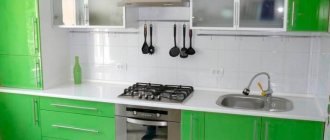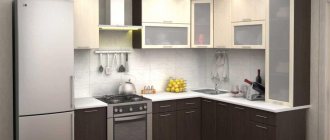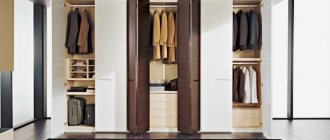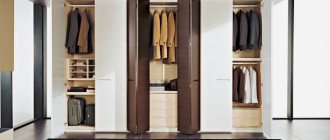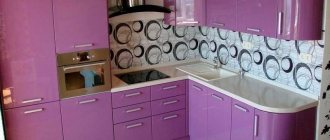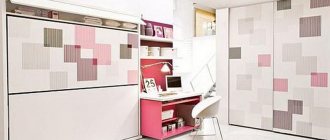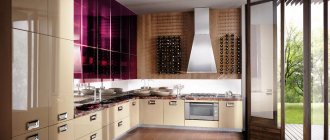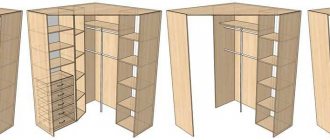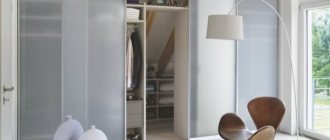Let's talk about how to make a cabinet yourself and install a hood in it in the kitchen.
Hoods have different designs; below we will talk about only two models: a simple built-in one (it is attached to the bottom of the cabinet) and a telescopic one (it is mounted in a cabinet in a special way). For such hoods it is necessary to design special cabinets. These are exactly what we will consider in this article.
Typically, the width of these hoods is 50 - 60 cm. The cabinet for such a hood should be the same width, and the depth should be at least 28 cm. That is, for a standard hood you need a standard cabinet that is equal in width to it.
The height of the cabinet is designed according to the owner of the kitchen, because she should be the one who should be comfortable using the hood. However, the distance from the stove to the hood must be at least 65 cm and no more than 85 cm. (Permissible error is 5 cm).
The depth of the upper horizon of the cabinet will be less than that of the lower one. Let’s say the depth of the lower horizon is 30 cm, then the depth of the upper horizon will be 12 cm. A difference of 18 cm is enough for the corrugation to fit freely there.
The back wall moves forward, this allows you to mask most of the “insides”.
You can, of course, make a very ordinary cabinet without a back wall. But its internal appearance is, to put it mildly, unimpressive. When you open the doors, you will see an empty space, an opening in the middle of the lower horizon, and a corrugation coming out of it. The spectacle is not very aesthetic.
But if there is a back wall and an additional shelf, the interior appearance becomes much nicer. The shelf can be used around the house, and it also adds rigidity to the cabinet.
Dimensions of hoods built into the cabinet
The width and depth of the hood built into the cabinet depend on the size of the stove. They should be at least equal to the width and depth of the hob or slightly exceed them. If the hood is purchased before the stove, then you can focus on the distance between the hanging cabinets on both sides of the hob.
The width can be divided into narrow, standard and wide.
Narrow hoods for closets
- up to 60 cm. Models with a width of 50 and 60 cm are often found, which corresponds to the width of a standard kitchen module. Thus, Faber INCA LUX 2.0 EG8 X A52, 52 cm wide with two types of filters, has a maximum power of 1050 m3/hour, effective even for a large kitchen.
Standard hoods for cabinets
- from 60 to 90 cm. They operate in both air exhaust and recirculation modes. In the catalog of the Hausdorf online store you can find models with widths of 73, 80, 85 and 90 cm with three or more suction speeds and electronic control.
Wide
- over 90 cm. Less common. We present them in models with a width of 110 and 118 cm. As a rule, these are high-tech products with low noise levels. For example, the Miele DA 2628 with efficient perimeter suction can be controlled from a smartphone.
What to consider when choosing
| Illustrations | Factors determining the choice of hood |
| Method of action . Hoods are either flow-through or circulation. The first remove air from the room into the ventilation shaft, and the second drive the air through a filter, clean it and re-direct it into the room. The choice of one modification or another is determined by the possibility or impossibility of laying an air duct. | |
| Material of manufacture . When choosing a particular air purifier model, pay attention to the coating of the bottom panel. It is preferable to choose modifications with a glossy surface, since glass or polished steel is easier to clean from soot. | |
| Lighting . The range of hoods includes models with lighting using halogen, fluorescent and LED lamps. I recommend choosing models that use LED lamps. This backlight heats up less, lasts longer and gives a brighter and more even glow. Due to its high brightness, a hood with LED lamps provides good illumination of the stove even when dirty. | |
| Productivity . Productivity is the volume of air that the device can pass through itself in 1 hour. To calculate productivity, we multiply the kitchen area by the ceiling height and get the volume of internal space. We multiply the resulting number by 12 - the air exchange rate according to sanitary standards, and then multiply by 1.6 - the minimum reserve correction factor. We compare the result with the device performance specified in the data sheet. |
Depth
For ease of use, models built into a cabinet or ceiling are made smaller in depth (usually 25-30 cm) and equipped with a telescopic panel. The total depth including the panel is from 40 to 60 cm.
When not in use or during normal operation, the panel does not extend and does not interfere with anyone standing at the stove. In intensive mode, the panel moves forward to more effectively remove contaminated air. For example, Elica CIAK GR/A/86 without a retractable panel is 27 cm deep, and with it - 42 cm.
Stages of work
Installation work begins with unpacking the hood kit and preparing the mounting surface
After the hood has been purchased and the necessary tools have been prepared, it’s time to begin installation. The installation steps are as follows:
- Preparatory work - dismantling the cabinet and disassembling it for subsequent stages;
- Cutting mounting holes for installing an air cleaner;
- Installation of the unit and connection to the air duct corrugation and electrics.
Let's consider the above points in more detail.
| Illustrations | Step-by-step description of installation work |
| Dismantling the cabinet . The cabinet is removed from the mounting brackets and placed on the table with the door up. Next, using a regular shaped screwdriver, remove the doors from their hinges, freeing access to the internal volume. | |
Removing the middle shelf. The middle shelf can be removed in two ways:
| |
| Working with the bottom surface of the cabinet . You will have to work on the bottom of the cabinet if the air purifier cuts into it. If the hood model allows for attachment to the side walls, then the lower part is generally dismantled and not used. To remove the lower part from the cabinet, 2 fastening screws (confirmation) are unscrewed from each side, after which the piece of chipboard is pulled towards itself. | |
| Cutting holes for the passage of the air duct. Some manufacturers provide their hoods with a mounting template - a drawing printed on thick paper, which is applied to the bottom of the cabinet and marks are made along the orientation holes for subsequent drilling and cutting. If there is no ready-made template, you will have to take and transfer the dimensions manually. To do this, the distance between the fixing screws is measured and the corresponding markings are applied on the removed bottom wall of the cabinet. We mark the center of the hole for the air duct and draw a circle with a compass and cut out a seat for the pipe. If you plan to install an intermediate shelf, we also cut a hole in it, as in the lower part, for the air duct. Also in this shelf at the back there is a small groove cut for the power cable outlet. | |
| Installation of all elements in the cabinet . The hood is installed with an outlet pipe into the hole and secured with self-tapping screws or screws to the bottom. An air duct is connected to the exhaust pipe using a clamp, which is threaded through the middle shelf. The dismantled cabinet elements are installed in their place, after which they can be fixed with screws. The power cable from the hood is connected to the electrical network. After completing the above work, the hood can be turned on and used for its intended purpose. |
Dimensions of kitchen hoods built into the ceiling
Hoods built into the ceiling
, are usually placed in kitchens with an “island” stove. Unlike conventional island designs, these flat designs do not clutter up the space. They are installed in ceiling modules made of plasterboard or under a suspended ceiling, and controlled from a remote control.
The width and depth also correspond to the dimensions of the hob and do not differ from the characteristics of hoods built into the cabinet. The Faber HIGH-LIGHT WH MATT A91 model, with a width of 91 cm and a depth of 50 cm, is suitable for the largest hob.
Installation of built-in hood. Required materials and tools
Correct installation of a kitchen hood
Let's consider the option when you decide that there is no need to make a new box, all that remains is to re-equip the existing wall cabinet. Before you begin installation, you need to decide on the material from which the ventilation duct will be made, and prepare the necessary tools so that everything is at hand.
Types of materials from which the air duct is most often formed.
Plastic air duct for connecting to the hood
Corrugated exhaust duct hidden behind the panel
Both types have a number of pros and cons. What to choose, you decide based on the parameters of the equipment, the capacity of the cabinet, and your preferences.
A structure made of flat rectangular pipes can be hidden in a suspended ceiling, almost without taking away the height of the room
The following tool will be useful for this work. For marking and measurements you need a tape measure, a square, a pencil. For cutting holes - a jigsaw, wood saws. A screwdriver, bolts, and screws will also come in handy. To glue joints, purchase adhesive sealant. To enhance the tightness, clamps are used; they need to be prepared.
Models built into the table
Hoods built into the table
, are retractable structures that are installed behind the hob or on the side of it. Less common are non-retractable models built into the countertop - for example, BORA CKASE. To install them, you need a cabinet under the hob. When not in use, these devices are almost invisible.
BORA built-in desk hoods
De Dietrich built-in table hoods
BORA built-in desk hoods
Miele built-in desk hoods
Their sizes vary widely depending on the design and installation location. Thus, the Miele CSDA 7000 FL model, installed flush on the side of the hob, is 12 cm wide and 52 cm deep. The De Dietrich DHD7261B pull-out model, installed behind the hob, is 118 cm wide, the height of the hidden part is 74 cm and the retractable part is 30 cm.
Advantages and disadvantages
There are different types of kitchen hoods:
- dome;
- hanging;
- built-in (fume hood).
The most cumbersome of them is the domed one; this option is definitely suitable only for large rooms. The built-in one takes up the least amount of space, but fits organically into the interior, making it stylish and modern.
The advantages of a built-in cabinet design:
- versatility, allowing you to merge with the interior, become part of it, and also not be conspicuous;
- compactness, small size, not taking up useful space;
- low volume of electricity consumption;
- minimum noise produced;
- variety of variations and models;
- wide range of colors;
- ease of installation, including do-it-yourself;
- good performance.
The good thing about a built-in hood is that it can be matched to any interior and placed in any kitchen, even the smallest one. This design has disadvantages, especially in comparison with other types of hoods:
- less power than a dome structure;
- lower productivity;
- the need to regularly replace the adsorbent filter;
- the need to regularly clean the grease filter.
But it is logical that a small built-in one will be less powerful and productive than a dome one. Performance is the volume of air that the hood passes through itself over a certain period of time. Therefore, for a smaller area, an appliance with a lower value will be enough, which means that a built-in hood will be just right for a small kitchen. And the variety of designs implies hoods with both a minimum working area and the possibility of expanding it.
Built-in
Hanging
Dome
Working with the bottom surface of the cabinet
To remove the part, just unscrew the side confirmations. You will first need to embroider the back wall, which is attached to the chipboard part. This is usually done with staples, but craft projects may use nails or screws. After opening the back wall, the side fasteners are removed and the bottom part of the cabinet is removed, which is not held back by anything.
If you need to cut a hole of the required size, which does not occupy the entire area of the bottom of the cabinet, you should follow several requirements:
- The hole should be cut so that the body of the built-in hood fits close to the front wall of the cabinet, and not the back. This will avoid disassembling the structure;
- The dimensions of the cut part are marked using a marker and a carpenter's corner;
- holes with a diameter of 10 mm are drilled so that their centers are clearly in the corners.
After this, the hole is cut. In practice, it is enough not to disassemble the cabinet, just remove it from the wall, dismantle the doors (for further convenience of working with the shelf), turn it over and do all the work on the floor. The following video clearly shows the work process.
A little trick. A jigsaw with a coarse wood saw and laminated chipboard is a thankless combination. When a saw with a straight tooth direction is used (bevel upward, undermining the material from below, cutting when the saw moves upward), chips are formed on the upper side of the slab to the side of the cutting line. This is an excellent place for moisture to enter and destroy the chipboard. You can do it in three ways. In the first case, the end surface and chipped areas are coated with waterproof glue. Surface defects will be hidden if the built-in hood design has a side. In the second case, you can take a saw with a reverse tooth (the cut is made when the cutting tool moves downwards). In this option, the chips will be inside the cabinet. However, the best way is to go deeper into the material along the cut line with a strong knife to a depth of 2-3 mm. After that, by carefully moving the saw with a straight tooth close to the formed line, you can avoid the appearance of chips. The cutting tool should be located on the side of the part that will be removed.
Additional features
When choosing a hood, an important factor is the additional functions that the device is equipped with. Among them we can highlight such a program as switching on at certain intervals. That is, the hood will start on its own and function for some time, regularly purifying the air in the kitchen.
There is also a residual run function, when the hood will be able to work for some time after switching off. This usually lasts from five to fifteen minutes, which allows you to make the air in the room perfectly purified. For more expensive models, there are programs that may not be the most necessary, but also no less useful. For example, an LCD screen for watching videos or connecting a computer. The weather system allows you to monitor the weather, while the fume hood is connected to a weather station on the street, and the results are displayed on the display.
Purpose of kitchen ventilation
During the cooking process, a whole bunch of dangerous chemicals are released into the air.
Among them are:
Carbon monoxide (CO), better known as carbon monoxide. An extremely toxic substance, even in small concentrations leading to severe poisoning of the entire body. And when the concentration of CO in a person’s blood reaches 5 ml per liter, almost instantaneous death occurs. The main danger of carbon monoxide is that it has neither color nor odor. Therefore, its dangerous concentration can be detected only by a sharply deteriorated state of health - a severe headache accompanied by vomiting. CO is released during any combustion, including when frying food on a stove fire.
- Natural gas (propane, butane, methane) is another dangerous chemical component present in the kitchen. It is commonly used as an energy carrier for gas cooktops. But in high concentrations it can not only cause human poisoning, but also cause fire and explosion. Every year, hundreds of people around the world become victims of gas leaks that could easily have been avoided with an effective ventilation system.
- Carcinogens are volatile substances released into the air when foods are fried or fats are burned in a frying pan. This is the same child that stands in the kitchen while preparing food, and then settles on the walls and ceilings of the room with a greasy coating. Carcinogenic substances, although they cannot lead to immediate death of a person, like CO or propane, are capable of accumulating in the human body. When these substances enter the liver, kidneys, and lungs, they ultimately cause severe pathologies, including cancer.
- Water vapor is released when cooking soups or boiling a kettle. By itself, it is absolutely harmless to humans. But in high concentrations it condenses on the walls and ceilings of interior spaces, causing the appearance of fungus and mold. The fungus significantly reduces the service life of finishing materials, and can also affect the load-bearing elements of the building structure. Microscopic spores released by mold into the air cause severe allergic diseases - dermatitis, asthma, chronic bronchitis.
Therefore, it is necessary to equip each kitchen with a ventilation system, in full compliance with the requirements and standards of SNiP and GOST. This will allow you not only to maintain hygiene in the kitchen, but also to preserve the health, and even the life, of the inhabitants of the apartment.
Manufacturers
Built-in hoods are produced by most manufacturers of household kitchen appliances, so that the entire room can be furnished entirely with equipment from one company. There are also companies specializing in hoods.
Popular manufacturers of similar designs:
- Bosch - this company has a good range of products from affordable models to premium ones. The latest models are equipped with a touch control panel and automatic selection of operating modes, filter indication, and an additional cleaning system. They are distinguished by their noiselessness;
- Krona - this company specializes in built-in kitchen appliances. Their hoods meet all modern requirements put forward by consumers. The sizes of hoods vary from 45 to 80 cm. There are both ultra-modern models and simpler ones;
- Elikor - products of a popular Russian manufacturer meet all international requirements and standards. Elikor hoods are produced not only in various colors, but also with decorative decorations in the form of gilding and carvings. A distinctive feature of this product is its unusual design (look at the photo);
- Hephaestus - hoods from this company are easy to operate and equipped with high-quality lighting. Their power and performance make the equipment suitable for both small and large spaces.
Whatever the brand is chosen, each of them has a product line full of a variety of models of hoods, from the most compact, allowing them to be built into a 50 cm cabinet, to 80 cm. And also in various colors and styles. A built-in kitchen hood is a universal solution for any room where culinary masterpieces are prepared. By installing it, you can forget about unpleasant odors, freshen the air and make cleaning much easier.
Types of filters
In a kitchen unit, the hood usually has double cleaning using carbon and plastic or aluminum filters. The former neutralize odors released during the cooking process. The latter collect particles of fat, soot, dust and other contaminants. Plastic cassettes contain filters made of padding polyester or non-woven fabric, but there are also metal options that require cleaning when they become dirty.
The fume hood can operate without using a fine carbon filter in its design. But at the same time, a grease filter is necessary so that contaminants do not settle on the hood mechanism itself. There are also budget models that operate without filters at all. Their job is to remove air through the ventilation duct, while taking in clean air from the outside.

